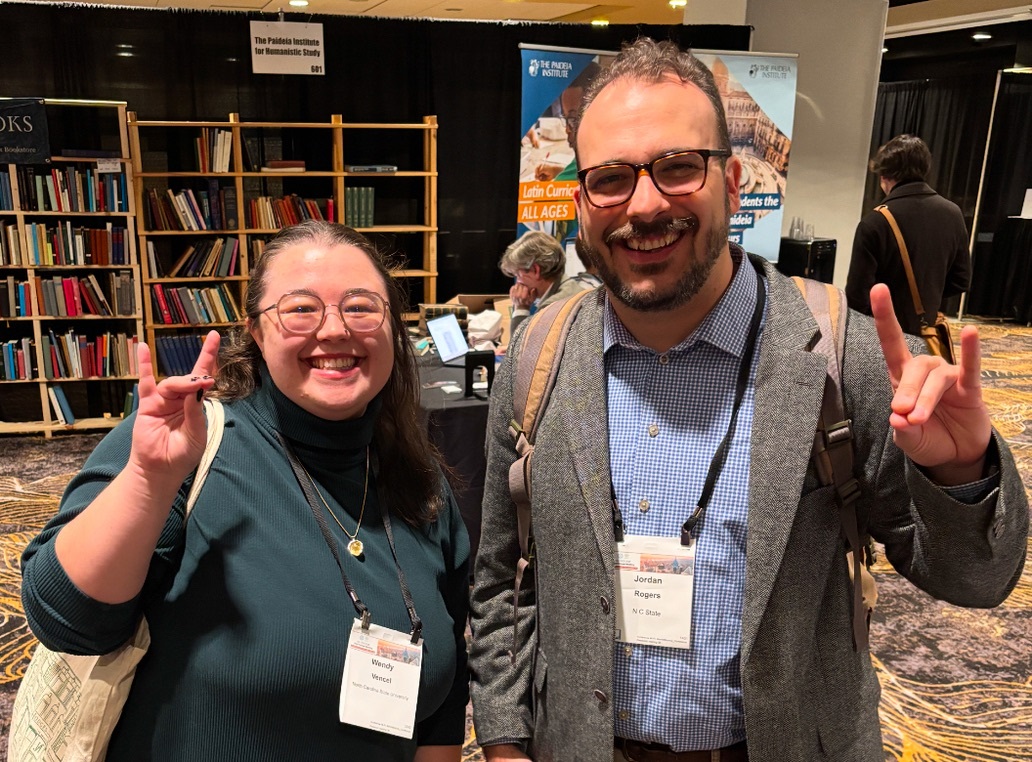Public History MA student, Alana Gomez, curates Special Collections Research Center’s newest exhibit.

Public History MA student, Alana Gomez, blogs about her experience curating a new exhibit at the Special Collections Research Center at D.H. Hill Jr. Library.
I remember the fear that sunk in when I was told I would curate the Special Collections Research Center’s (SCRC) newest exhibit, College of Design: 75 Years of Designing Tomorrow. After my first excitement over the opportunity, I quickly realized I didn’t know anything about architecture. There is more to the College of Design than just buildings, construction, and planning, however.
During the Fall of 2023 and Spring of 2024, I became immersed in the people, narratives, and legacies of departments like graphic design, urban planning, product design, and landscape architecture. While popular names like Eduardo Catalano and Matthew Nowicki appeared frequently in the archives, I was also drawn to the stories of students and faculty like Jean MacKensie Jenkins and Ronald Mace who challenged traditional design principles and practices. Sharing their stories and highlighting the creativity and passion of students over 75 years was integral to capturing the spirit of the College of Design.
Before sharing more on my experience with this exhibit, however, I want to take a second to recognize the people who have worked alongside me and the opportunity that allowed me to be here today.
Firstly, it is important to note that I was awarded this Graduate Student Support Plan position, or GSSP, through the Libraries. For those who don’t know, the GSSP/GEA position waived my tuition and provided a stipend while also allowing me to gain real-world experience in my field. Not only was I afforded the opportunity to curate and install an exhibit, but I was also given the tangible experience of working in a setting like Special Collections, which has prepared me tremendously for the professional world. Secondly, I would like to thank the public history department and my mentors there for teaching me the necessary skills and experience to succeed in this position.
Finally, it is important that I shout out those who helped this exhibit come to life. I would like to thank the library preservation team, design team, and all of the Special Collections staff who have rooted me on at every turn in this process. Specifically I’d like to thank Associate Head and Chief Curator of Special Collections and Affiliate Graduate Faculty Member Dr. Gwynn Thayer and University Archivist Todd Kosmerick for their guidance and supervision. Dr. Thayer was recently featured in an article titled Topics in History and Memory: The Pinehurst/Taylortown Project.
Additionally, I’d like to recognize the work of my two fellow graduate students, Kelly Arnold, who recently graduated from the public history master’s program, and Shima Hosseininasab, soon to graduate from the public history PhD program, for their help with research, advising, and graphics.
Now, I’d like to start my discussion of this exhibit and its curation with a note about the title. As I went through the archives and my colleagues’ notes, there were a few themes that came up repeatedly, and I think many of them are present throughout the exhibit. What stuck out to me was a passion for the design process and a rejection of preconceptions associated with the past. Students were encouraged by faculty to push the boundaries of design, to experiment, and to produce the best design possible.
Another constant were the students, who consistently brought a spirit of constant curiosity and dedication to their craft. Because so much of the College of Design’s research and analysis fell into these recurring ideas, we decided on a thematic rather than chronologic curation style. Many of the cases in the exhibit include nods to this dedication to the best design, straying from tradition, and the student spirit that was present in every decade of the College.
With all these themes in mind, my team and I felt there was also an element to the College of Design that was very forward-thinking. Even contemporary designs by faculty and students had long-term impacts that we still talk about today. The College of Design operated in the world of “tomorrow,” and it was that kind of thinking that has created such an important legacy.
If I had to sum up this exhibit in one sentence it would be “Since its early days in the old World War II barracks on campus, the College of Design has remained a space that, throughout time, allowed for constant curiosity, freedom of expression and experimentation, and the pushing of boundaries.” But I also hope people take a moment to read about those stories, designs, and people not always included in what we historians like to call the “traditional” narrative. It was in discovering these moments in history and finding these more “hidden” histories in the archives that I enjoyed the most.
Finally, please join me for an exhibit walk & talk tour that will feature a guided tour followed by a curator talk and an exclusive hands-on look at original materials from Special Collections. Registration for this event is available in the above and following links for either April 12th from 11am-12pm and April 26th from 11am-12pm.
I’d also like to direct attention to some blog posts I wrote that are located on the SCRC website. These blogs are also present in the exhibit as QR codes.
College of Design History — The Construction of Archives
College of Design History — A tour of the COD around campus
College of Design History — The Early Artists
College of Design History– 75 Years of Design Curriculum
College of Design History– Challenging the Norm Through Design
College of Design History- George Matsumoto
- Categories:


